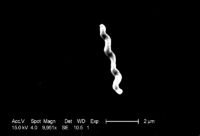Difference between revisions of "Campylobacter jejuni"
| (18 intermediate revisions by 2 users not shown) | |||
| Line 1: | Line 1: | ||
| − | {{ | + | {{review}} |
| − | Also known as: '''''C. | + | |
| + | Also known as: '''''C.jejuni''''' | ||
| + | |||
| + | |||
{{Taxobox | {{Taxobox | ||
|name =''Campylobacter jejuni'' | |name =''Campylobacter jejuni'' | ||
| Line 7: | Line 10: | ||
|order =Campylobacterales | |order =Campylobacterales | ||
|family =Campylobacteraceae | |family =Campylobacteraceae | ||
| − | |genus = | + | |genus =Campylobacter |
|species =''C.jejuni'' | |species =''C.jejuni'' | ||
}} | }} | ||
| − | |||
[[File:jejuni.jpg|thumb|200px|right|''Campylobacter jejuni'' Marco Tolo 2006, WikiMedia Commons]] | [[File:jejuni.jpg|thumb|200px|right|''Campylobacter jejuni'' Marco Tolo 2006, WikiMedia Commons]] | ||
| − | |||
| − | + | ''Campylobacter jejuni'' belongs to the genus [[Campylobacter species - Overview|''Campylobacter'']]. ''C.jejuni'' is an important enteropathogen of man and a number of animal species. It is the largest cause of food-poisoning in the UK and is therefore a public health issue. | |
| − | + | It is widespread on farms and is hyperendemic. It can be carried as commensals in the intestines of cattle, sheep, dogs, wild birds and especially chickens. | |
| − | Animals with little exposure are very susceptible, e.g. humans and pets. | + | Farm animals are regularly exposed via the faecal-oral route. Maternal antibody protects the animal while the active immunity develops. Animals with little exposure are very susceptible, e.g. humans and pets. |
| − | + | Most chicken carcasses are contaminated, leading to food poisoning and enterocolitis in people from uncooked meat. If frozen chicken is inadequately thawed, bacteria may remain viable in the abdominal cavity | |
| − | |||
| − | |||
==Pathogenesis== | ==Pathogenesis== | ||
The pathogenesis of ''C.jejuni'' involves the colonisation, attachment and invasion of colonic enterocytes and toxin production. | The pathogenesis of ''C.jejuni'' involves the colonisation, attachment and invasion of colonic enterocytes and toxin production. | ||
| + | It causes colitis, characterised by; Necrosis of absorptive epithelial cells; Erosion of the mucosa; Crypt abscesses; The infiltration of inflammatory cells into the mucosa and the presence of primarily [[Neutrophils|neutrophils]]. | ||
| + | The bacteria's functional flagella are important as virulence factors. Non-flagellate [[Campylobacter species - Overview|campylobacter]] do not colonise in vivo, and are less invasive. | ||
| + | It causes enteritis and diarrhoea in susceptible dogs and causes abortion in ewes. | ||
| + | It usually causes asymptomatic infections in chickens and turkeys, but occasional outbreaks of avian [[ Hepatitis, Acute|hepatitis]] occur. | ||
| + | It is implicated in [[Calf Diarrhoea, Undifferentiated Neonatal|undifferentiated neonatal calf diarrhoea]], a mixed viral enteritis in calves. | ||
| + | ''C.jejuni'' is diagnosed by laboratory diagnosis. | ||
| − | + | ==Literature Search== | |
| − | |||
| − | |||
| − | |||
| − | |||
| − | + | [http://www.cabdirect.org/search.html?q=%28%28title%3A%28%22Campylobacter+jejuni%22%29+AND+yr%3A%5B2000+TO+2010%5D%29%29+AND+%28%28title%3A%28%22Campylobacter+jejuni%22%29+AND+ab%3A%28%22Food+safety%22%29+OR+ab%3A%28%22Public+health%22%29%29%29&fq=subject_facet%3A%22Campylobacter+jejuni%22&fq=gl_facet%3A%22UK%22 ''Campylobacter jejuni'' in the UK] | |
| + | [[Category:Campylobacter_species]] | ||
| − | |||
| − | |||
| − | |||
| − | |||
| − | + | [[Category:Enteritis,_Bacterial]] | |
| − | |||
| − | |||
| − | [[Category: | + | [[Category:To_Do_-_AimeeHicks]] |
| − | + | [[Category:Expert_Review]] | |
| − | |||
| − | [[Category: | ||
Revision as of 13:49, 14 September 2010
| This article has been peer reviewed but is awaiting expert review. If you would like to help with this, please see more information about expert reviewing. |
Also known as: C.jejuni
| Campylobacter jejuni | |
|---|---|
| Phylum | Proteobacteria |
| Class | Epsilon Proteobacteria |
| Order | Campylobacterales |
| Family | Campylobacteraceae |
| Genus | Campylobacter |
| Species | C.jejuni |
Campylobacter jejuni belongs to the genus Campylobacter. C.jejuni is an important enteropathogen of man and a number of animal species. It is the largest cause of food-poisoning in the UK and is therefore a public health issue. It is widespread on farms and is hyperendemic. It can be carried as commensals in the intestines of cattle, sheep, dogs, wild birds and especially chickens. Farm animals are regularly exposed via the faecal-oral route. Maternal antibody protects the animal while the active immunity develops. Animals with little exposure are very susceptible, e.g. humans and pets. Most chicken carcasses are contaminated, leading to food poisoning and enterocolitis in people from uncooked meat. If frozen chicken is inadequately thawed, bacteria may remain viable in the abdominal cavity
Pathogenesis
The pathogenesis of C.jejuni involves the colonisation, attachment and invasion of colonic enterocytes and toxin production. It causes colitis, characterised by; Necrosis of absorptive epithelial cells; Erosion of the mucosa; Crypt abscesses; The infiltration of inflammatory cells into the mucosa and the presence of primarily neutrophils. The bacteria's functional flagella are important as virulence factors. Non-flagellate campylobacter do not colonise in vivo, and are less invasive. It causes enteritis and diarrhoea in susceptible dogs and causes abortion in ewes. It usually causes asymptomatic infections in chickens and turkeys, but occasional outbreaks of avian hepatitis occur. It is implicated in undifferentiated neonatal calf diarrhoea, a mixed viral enteritis in calves. C.jejuni is diagnosed by laboratory diagnosis.
